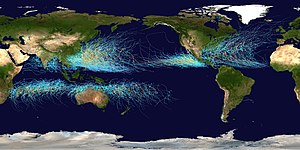Tropical cyclogenesis
Appearance

Tropical cyclogenesis is a meteorological word used to describe tropical cyclone formation, and its strengthening over the atmosphere.[1] Tropical cyclogenesis happens when the development of a warm-core cyclone, is associated with a lot of convection in a favorable atmospheric environment. Usually, about 86 tropical cyclones of tropical storm strength form worldwide every year, with 47 reaching hurricane/typhoon strength, and 20 becoming strong tropical cyclones (at least Category 3 intensity on the Saffir-Simpson Hurricane Scale).[2]
Related pages
[change | change source]References
[change | change source]- ↑ Arctic Climatology and Meteorology. "Definition for Cyclogenesis". National Snow and Ice Data Center. Archived from the original on 2006-08-30. Retrieved 2006-10-20.
- ↑ Chris Landsea. "Climate Variability table - Tropical Cyclones". Atlantic Oceanographic and Meteorological Laboratory, National Oceanic and Atmospheric Administration. Retrieved 2006-10-19.
Other websites
[change | change source]- Current AO conditions
- Current ENSO conditions
- Current MJO conditions
- Current NAO conditions
- Current PNA conditions
- Maximum Potential Intensity
- Maximum Potential Intensity Maps Worldwide
- Tropical Cyclone Heat Potential
